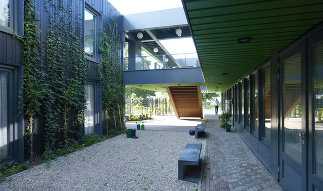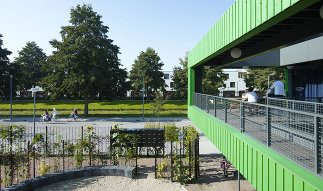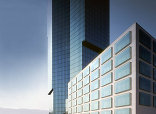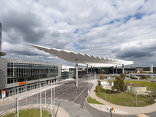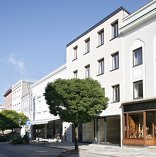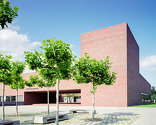Bauwerk
Co-Housing Garden Rooms
van Bergen Kolpa Architecten - Hoogvliet (NL) - 2011
23. November 2011 - newroom
Co-Housing is a series of neighbourhood communities in which like-minded live together around a communal garden. The Co-housing project takes the opportunity to reinterpret the ideal of the garden city to contemporary social conditions. The care program and the resulting specific social needs play a special role in the plan.
The project Co-Housing is realised in the garden city Hoogvliet, a former dike town that went through a large scale expansion in the fifties and sixties, becoming a satellite town of Rotterdam to house the workers of BPM (currently Shell). After a long period of decay an initiative was started to bring new life into the garden city. The Co-Housing project is a result of the manifestation WiMBy! (Welcome into My Backyard!) that took place from 2001 untill 2007 in Hoogvliet. This International Building Exhibition was the kick-off for the upcoming urban renewal operation.
Co-Housing Hoogvliet, consisting of the projects Neighbourship and Garden Rooms, was designed by Van Bergen Kolpa Architects, commissioned by Vestia Rotterdam.
Project description
The appartment building De Tuinkamers (Garden Rooms) at the Barbeelsingel forms, as a part of the Co-housing project, an urban ensemble together with the urban modules (stamps) of the Nabuurschappen. The hedges and collective outside spaces are, as in the Nabuurschappen project, binding elements in this project.
The building houses 37 small apartments for people that are mentally disabled and collective services and 24 hour guidance. The building mass embraces the collective outside spaces by means of a covered veranda. The occupants are apart from disabled people also young people who have been selected for their affinity with this vulnerable group. Together they share a bicycle-room, a sports room, and a hang-out room. These functions are framed by a metal mesh fence with all sorts of creepers, that swings around the garden rooms.
The extraordinary wide stairwell at the main entrance is the hinge connecting all functions; the collective kitchen and the living room inside the building, the hangout room outside and the overhanging balcony overlooking the gardens and the canal across the street. All apartments are equipped with a bench next to the front door in order to create a smooth transition between the private and public.
Experiences of the user: Stichting Pameijer
Pameijer’s central objective is to tie in with society. Els van Kooten (Pameijer): „The project radiates exactly what Pameijer likes to propagate; the promotion of an independent lifestyle and contact with society by creating meeting opportunities. Because the hedge is partially open, or so low that you can step over it, a balance must be found between the appropriation of private property and just openness to the environment. This is sometimes difficult, but it is at the same time exactly what the residents must learn to maintain themselves in our - to them - complex society.“
Els van Kooten: "The conditions of contact are very good and at the same time there is plenty of privacy so you‘re not on each other‘s lips. The open design of the building and the color of the facade generates positive interest from neighborhood residents. The vegetation makes it more friendly. Therefore the recruitment of volunteers has become easier.”
Els van Kooten: "In this project a group of young people have been selected to live together with a small community of mentally disabled people. This created the expectation that this would bring a lot of interaction. In practice, everyone is quite busy and it‘s not a bad thing: It feels just a matter of course. One of the youngsters has put this into words very nicely: „You do not see the restrictions anymore – you see the person.“
The project Co-Housing is realised in the garden city Hoogvliet, a former dike town that went through a large scale expansion in the fifties and sixties, becoming a satellite town of Rotterdam to house the workers of BPM (currently Shell). After a long period of decay an initiative was started to bring new life into the garden city. The Co-Housing project is a result of the manifestation WiMBy! (Welcome into My Backyard!) that took place from 2001 untill 2007 in Hoogvliet. This International Building Exhibition was the kick-off for the upcoming urban renewal operation.
Co-Housing Hoogvliet, consisting of the projects Neighbourship and Garden Rooms, was designed by Van Bergen Kolpa Architects, commissioned by Vestia Rotterdam.
Project description
The appartment building De Tuinkamers (Garden Rooms) at the Barbeelsingel forms, as a part of the Co-housing project, an urban ensemble together with the urban modules (stamps) of the Nabuurschappen. The hedges and collective outside spaces are, as in the Nabuurschappen project, binding elements in this project.
The building houses 37 small apartments for people that are mentally disabled and collective services and 24 hour guidance. The building mass embraces the collective outside spaces by means of a covered veranda. The occupants are apart from disabled people also young people who have been selected for their affinity with this vulnerable group. Together they share a bicycle-room, a sports room, and a hang-out room. These functions are framed by a metal mesh fence with all sorts of creepers, that swings around the garden rooms.
The extraordinary wide stairwell at the main entrance is the hinge connecting all functions; the collective kitchen and the living room inside the building, the hangout room outside and the overhanging balcony overlooking the gardens and the canal across the street. All apartments are equipped with a bench next to the front door in order to create a smooth transition between the private and public.
Experiences of the user: Stichting Pameijer
Pameijer’s central objective is to tie in with society. Els van Kooten (Pameijer): „The project radiates exactly what Pameijer likes to propagate; the promotion of an independent lifestyle and contact with society by creating meeting opportunities. Because the hedge is partially open, or so low that you can step over it, a balance must be found between the appropriation of private property and just openness to the environment. This is sometimes difficult, but it is at the same time exactly what the residents must learn to maintain themselves in our - to them - complex society.“
Els van Kooten: "The conditions of contact are very good and at the same time there is plenty of privacy so you‘re not on each other‘s lips. The open design of the building and the color of the facade generates positive interest from neighborhood residents. The vegetation makes it more friendly. Therefore the recruitment of volunteers has become easier.”
Els van Kooten: "In this project a group of young people have been selected to live together with a small community of mentally disabled people. This created the expectation that this would bring a lot of interaction. In practice, everyone is quite busy and it‘s not a bad thing: It feels just a matter of course. One of the youngsters has put this into words very nicely: „You do not see the restrictions anymore – you see the person.“
Für den Beitrag verantwortlich: newroom
Ansprechpartner:in für diese Seite: nextroom
Akteure
ArchitekturBauherrschaft
Fotografie
